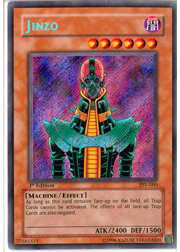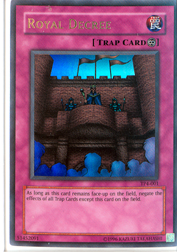With the rise of counter cards that are designed to either prevent or destroy many lovable mainstays, such as Scapegoat and Torrential Tribute, we should reexamine the principles behind the effectiveness of both prevention and destruction effects. Let’s start by taking a close look at both types of effects.
Preventing the Activation of Your Opponent’s Options
 There are numerous examples of prevention effects, which could also appropriately be called “delaying the inevitable.” The most famous example—one whose dominance almost transcended the metagame during the heyday of Pharaoh’s Servant—is Jinzo, which is still the best tribute monster in the game. Jinzo does not provide any card advantage through its effect. Instead, it simply prevents the activation of all traps until (and this is a very big until) it is removed from the field. This means that unless you deal 8000 points of damage to your opponent while Jinzo remains on the field, the card doesn’t provide any sort of direct resource advantage.
There are numerous examples of prevention effects, which could also appropriately be called “delaying the inevitable.” The most famous example—one whose dominance almost transcended the metagame during the heyday of Pharaoh’s Servant—is Jinzo, which is still the best tribute monster in the game. Jinzo does not provide any card advantage through its effect. Instead, it simply prevents the activation of all traps until (and this is a very big until) it is removed from the field. This means that unless you deal 8000 points of damage to your opponent while Jinzo remains on the field, the card doesn’t provide any sort of direct resource advantage.
Jinzo’s effect neatly illustrates the core of the philosophy of “delaying the inevitable.” There are plenty of cards that can prevent the activation of some valuable part of your opponent’s strategy while they remain on the field. If your opponent has some sort of monster removal to get rid of any nuisances, that monster’s negation effect will deflate like a dejected balloon.
Take a look at the numerous examples of negation out there. The aforementioned Jinzo, King Tiger Wanghu, Royal Oppression, Dark Balter the Terrible, Royal Decree, Asura Priest, Giant Trunade, and other such cards aren’t typically played to generate card advantage. Instead, these cards are played to limit the opponent’s options.
Imagine that you summon D.D. Survivor, expecting that the effect of Bottomless Trap Hole will be prevented by its effect. Your assessment of the situation might be correct, but what’s to prevent your opponent from simply saving Bottomless Trap Hole for a future monster? Wouldn’t using Dust Tornado instead improve your situation immediately?
Playing cards that force your opponent to stockpile resources is generally a terrible idea. Instead, by using destruction effects to generate card advantage, you can achieve a more desirable outcome than an end game blitz of an opponent unloading seven to eight resources in one turn.
Destroying Your Opponent’s Options
In direct contrast to preventing your opponent’s options is destroying them altogether. Cards such as Breaker the Magical Warrior, Heavy Storm, and Mystical Space Typhoon will permanently rid the field of threats. In all of these cases, instead of worrying about whatever your opponent will drop after your negating presence is gone, you can simply destroy those resources outright.
 A quick example involves Asura Priest. Summoning Asura Priest before Scapegoat resolves may simply cause your opponent to hold on to the Sheep tokens, choosing to take 1700 damage instead. In this case, you’re losing a normal summon for zero resource advantage, except perhaps for a slight advantage in life points. Instead, if you wait until the Sheep tokens hit the field before summoning Asura Priest, you’ll get to destroy an entire card (Scapegoat) for the price of a normal summon. In this case, you’ve just forced an uneven trade by taking away one of your opponent’s resources!
A quick example involves Asura Priest. Summoning Asura Priest before Scapegoat resolves may simply cause your opponent to hold on to the Sheep tokens, choosing to take 1700 damage instead. In this case, you’re losing a normal summon for zero resource advantage, except perhaps for a slight advantage in life points. Instead, if you wait until the Sheep tokens hit the field before summoning Asura Priest, you’ll get to destroy an entire card (Scapegoat) for the price of a normal summon. In this case, you’ve just forced an uneven trade by taking away one of your opponent’s resources!
A more complex example involves Dark Balter the Terrible. In the old days when Magical Scientist roamed freely, Dark Balter was usually summoned to negate an effect monster, once again causing your opponent to lose a resource. In today’s format, where Metamorphosis is the only possible way of bringing Dark Balter the Terrible out onto the field, many duelists make the mistake of waiting until the second main phase to drop him. In this case, your opponent will simply hold on to all of his or her good effect monsters, like Magician of Faith, Sangan, and Sinister Serpent, and simply try to hold off Dark Balter with traps and spells. In this case, Dark Balter the Terrible provides no sort of advantage.
On the other hand, if you drop Dark Balter when your opponent already has a set effect monster, you’ve just netted a resource advantage! Knowing the difference between destroying your opponent’s options and merely limiting them will spell the difference between victory and defeat!
Negating Options: A Balance Between the Two
There are also cards in the game that can generate massive advantage by both negating and destroying your opponent’s options. The two best examples of this are Imperial Order and Royal Decree.
 In both cases, the proper activation of either trap card will cause a resource loss for your opponent, and then either card’s effect will completely prevent spells or traps from being activated until your opponent can remove it. Many duelists make the mistake of activating Royal Decree during the end phase, or activating Call of the Haunted on Jinzo. In both of these cases, the cards are merely being used to prevent options by holding them down for a few turns.
In both cases, the proper activation of either trap card will cause a resource loss for your opponent, and then either card’s effect will completely prevent spells or traps from being activated until your opponent can remove it. Many duelists make the mistake of activating Royal Decree during the end phase, or activating Call of the Haunted on Jinzo. In both of these cases, the cards are merely being used to prevent options by holding them down for a few turns.
Instead, if you choose to wait until your opponent activates a trap and then activate Royal Decree, your opponent will lose his or her trap and suffer from the drawbacks of a dead set of trap cards. I smell a win-win proposition!
Another good example is Necrovalley, the field spell that can now safely be put into any deck that’s running Gravekeeper’s Spy. In this case, dropping Necrovalley on turn 1 would simply make your opponent hold on to all of his or her copies of Call of the Haunted, Premature Burial, and other graveyard-targeting effects. However, if you choose to wait until your opponent sets Magician of Faith and then activate Necrovalley, you’ll get an immediate resource advantage and still negate all graveyard effects!
The Moral of the Story
Generally, it’s preferable to destroy your opponent’s options rather than to simply delay them. While Jinzo might buy you a few turns of trap relief, a simple monster removal tool will whisk away such security in a flash. At that point, those two traps you were negating are still free to wreak havoc. The best outcome is the negation of an opponent’s individual resource followed by a blanket negation effect. Great examples of cards that generate these types of outcomes are Royal Decree, Dark Balter the Terrible, and Necrovalley.
As a general golden rule, it is not conducive to the champion player’s style of play to simply drop monsters, like King Tiger Wanghu, that delay the inevitable special summoning of Scapegoat. A common play may involve the following sequence of events.
Expecting to see Scapegoat, I’ll summon King Tiger Wanghu. My opponent will allow me to attack for 1700 life points. Next turn, he’ll drop Kycoo the Ghost Destroyer. Kycoo attacks for 100 damage. Because my King Tiger Wanghu has disappeared and isn’t easily replaceable, I’m back to square one, so to speak, and that Scapegoat that I was trying to avoid can now be activated at any point in the duel.
Don’t fall into the trap of buying security by trying to delay the inevitable activation of your opponent’s resources—destroy those resources instead.